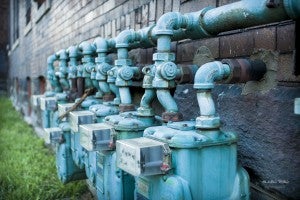STUDY: A Closer Look at Urban Methane Pollution
 The United States produces approximately 33 trillion cubic feet of natural gas each year. A majority of this gas is converted to electricity at power plants or used for industrial purposes, but about one third ends up making the journey from the well head, through underground pipelines, and into our homes and businesses. How much of this gas gets lost along the way—whether it’s through leaky equipment or other factors—is important because of the damaging climate impacts of methane pollution. And a new study published this week in Environmental Science and Technology is helping to expand our understanding of methane emissions in urban environments.
The United States produces approximately 33 trillion cubic feet of natural gas each year. A majority of this gas is converted to electricity at power plants or used for industrial purposes, but about one third ends up making the journey from the well head, through underground pipelines, and into our homes and businesses. How much of this gas gets lost along the way—whether it’s through leaky equipment or other factors—is important because of the damaging climate impacts of methane pollution. And a new study published this week in Environmental Science and Technology is helping to expand our understanding of methane emissions in urban environments.
The study—a multi-year collaboration led by Washington State University and included researchers from Aerodyne, the National Institute of Standards and Technology, GHD, Purdue and Pennsylvania State universities—used a variety of techniques to measure the rate at which methane is lost to the atmosphere in Indianapolis, Indiana.
This is the second paper in which EDF’s research partners have looked at methane pollution in an urban environment, and the results reveal regional variations. Last year researchers in Boston—an old city with a vast network of aging local gas pipelines—found natural gas was being emitted at a rate of about 38 kilograms per person. That’s enough natural gas to fuel about 200,000 homes each year. By contrast, in Indianapolis—which recently replaced much of its leak-prone, cast iron pipelines with tighter plastic pipes—emissions were almost 50 percent less per person. These results confirm our previous understanding that old pipes are prone to leaks. But, it also indicates that aging gas pipelines are not the only source of natural-gas derived methane emissions.
This study, similar to the one in Boston, relied on measurements from aircraft flying downwind of the city as well as from sensors placed on cell towers to detect emissions from the city. These results were then paired with site-level measurements and other data. Not unlike other EDF-coordinated studies, this study found that when estimating emissions based on site-level measurements, methane emissions were lower than aircraft or tower-based measurements. In fact in Indianapolis, airborne methane emissions estimated from the aircraft or tower data were anywhere from 3.5 to 6.9 times higher than emissions estimated from specific sources, such as pipes and metering and regulating stations.
The difference between the amount of emissions found at the source versus in the air, from regional methane pollution studies suggest that there are other city sources, beyond the natural gas pipeline and delivery system. Indianapolis has far fewer miles of leaky pipes than Boston, but its fossil fuel emissions still clocked in at a higher rate than previous research indicates—like our methane mapping of gas utility pipelines in these cities. This tells us that some combination of other natural gas sources, like gas meters, furnaces, boilers and hot water heaters are most likely responsible for at least a part, and maybe a significant fraction, of these yet uncharacterized local emissions.
Landfills are another major source to consider. For example, researchers found that one of the largest landfills in Indianapolis was responsible for about one third of the city’s total methane pollution. This revelation comes as EPA just finalized revised emission standards that limit methane emissions from both existing and future-built landfills. There are still additional, important opportunities to reduce methane from these types of biological sources that can complement federal and state efforts to curb this pollution across the oil and gas industry, the nation’s largest methane emitter.
A big takeaway from this study is that a better understanding of end-use methane emission sources is needed. Fortunately EDF—working closely with several university partners—has already started undertaking some of this work, including efforts to analyze emissions from residential and commercial end-use, so we can forge the solutions to make more efficient use of our energy resources and create a cleaner environment.
Photo Source: allenran 917 / Flickr











